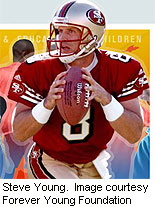
WEDNESDAY, May 4 (HealthDay News) — Parents who suspect their child has sustained a concussion while playing sports should immediately pull players off the field — even at the risk of embarrassing their kid — to avoid a potentially permanent brain injury, according to football legend Steve Young.
During a Monday news conference on youth sports injury prevention held by Safe Kids USA, Young joined experts to outline what parents should look for when dealing with some of the most serious athletic injuries, such as concussions, heat stroke, and muscle and joint overuse.
Young, a former NFL quarterback who was inducted into the Pro Football Hall of Fame in 2005, said he suffered many concussions during his storied 30-year career, an issue “now coming to the forefront, as it should be.”
“It’s a nefarious injury with all kinds of gradations, each contextual to the person,” Young said. “You just don’t know how certain things will affect you. The key is not to push it — that’s always a very dangerous mistake.”
About 10 percent of the 38 million American kids participating in sports each year are treated for a sports-related injury, but the U.S. Centers for Disease Control and Prevention estimates that about half these injuries are preventable.
A recent national survey sponsored by Safe Kids USA and Johnson & Johnson found that parents generally expressed little concern about the number of potential injuries their kids could sustain playing team sports, with only concussions and dehydration causing “a great deal” or “quite a bit” of worry.
About 86 percent of the parents surveyed said their child’s injury was “just part of the game” and that it probably would have happened anyway. The survey was a follow-up to similar research done in 2000 that studied parents’ knowledge, attitudes and behaviors on youth sports safety.
“There’s far more benefit to sports involvement than risk, but we’ve got to manage that risk properly,” Gerard Gioia, director of the Safe Concussion Outcome, Recovery & Education (SCORE) program at Children’s National Medical Center, said at the news conference.
Gioia and Young advised parents to be alert to any changes in a child’s behavior in the moments after a blow to the head or body that causes the head to jerk forward, which can cause a concussion. Most of the time, the player will not lose consciousness, but may appear dazed, stunned or simply out of sorts.
“As a parent, I would embarrass my child or I would embarrass the coach if I think they’re acting differently,” Young said. “There’s a tremendous pressure to stay on the field and that’s why in many ways, athletes are not the best judges [of their abilities]. In fact, in many ways, they’re the worst judges.”
To prevent heat stroke, which can occur during heavy exertion and high temperatures, kids should monitor their urine color before practices and games to calculate their fluid needs, said Douglas Casa, chief operating officer of the Korey Stringer Institute at the University of Connecticut.
Athletes should aim to drink enough fluids for their urine to be the color of lemonade rather than the color of apple juice, Casa said. Water is fine for events under an hour, he added, while sports drinks such as Gatorade are a better pick for events longer than an hour that require more electrolytes.
Overuse injuries — such as the so-called pitcher’s elbow — are caused by repetitive muscle and joint movements that break down tissue without giving it a chance to heal, Casa said. Safe Kids USA recommends that young athletes take 10 weeks off per year from the same sport played over multiple seasons.
Children involved in team sports spend an average of 7.4 hours each week practicing or playing in games, with boys spending about 20 percent more time than girls, and 10- to 14-year-olds spending significantly more time than 5- to 9-year-olds.
Nearly all parents surveyed felt organized team sports provide positive experiences for their children, and 31 percent said learning values such as teamwork and sportsmanship was the most important benefit. Surveyed sports included football, soccer, field hockey, basketball, gymnastics, ice hockey, lacrosse, baseball, softball and T-ball.
Young advised parents to learn the rules of the sports their children play and get to know their coaches, but not to push them to play the game itself. That motivation needs to come from the kids, he said.
“If you’re leading the way and pushing it, I don’t know if that’s healthy over a period of time,” he said.
More information
For more on youth sports safety, go to the U.S. National Institutes of Health.

